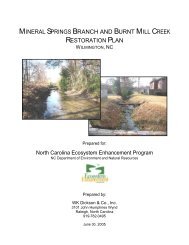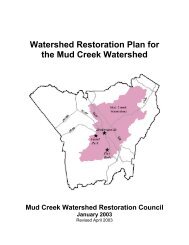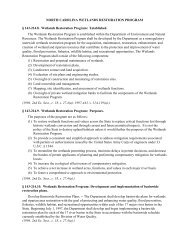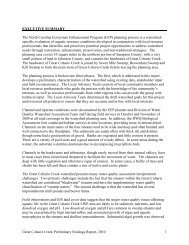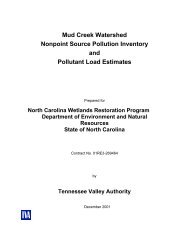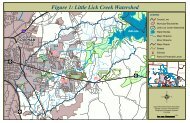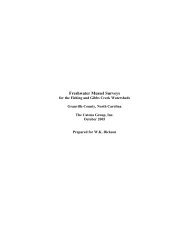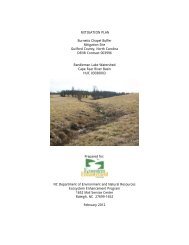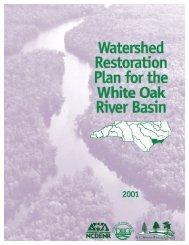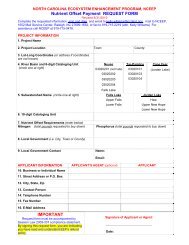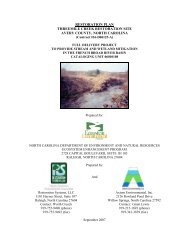RESTORATION PLAN Glade Creek Stream Restoration Alleghany ...
RESTORATION PLAN Glade Creek Stream Restoration Alleghany ...
RESTORATION PLAN Glade Creek Stream Restoration Alleghany ...
You also want an ePaper? Increase the reach of your titles
YUMPU automatically turns print PDFs into web optimized ePapers that Google loves.
By far the most prevalent soil series in the watershed is the Watauga series (44%, Typic Hapludults)followed by Chester (16%, Typic Hapludults) and Porters (12%, Typic Dystrudepts) soils. All theseseries are upland soils, and no hydric soil is included in the list, although it is assumed that thealluvial land category may contain hydric soils.2.4 Historical Land Use and Development TrendsThe main land use patterns for the <strong>Glade</strong> <strong>Creek</strong> watershed upstream of the project are approximately44% (1,500 ac) Managed Herbaceous Cover (pasture), and 36% (1,226 ac) forested in Mixed UplandForest (see Table 3 in Section 9). A major component of <strong>Alleghany</strong> County’s economic history andpresent economy is dairy and livestock production. The high percentage of pasture in the watershedreflects this economic trend. A major cause of accelerated stream bank erosion can be related to landuse change (Henderson, 1986). For decades livestock and dairy production has known to compactsoils, increase stormwater runoff and increase sediment loading in stormwater. For example,overgrazing and soil compaction in the uplands often lead to rill erosion and elevated peak flowsinstream. Soil can become compacted by the repeated pressure of moving animals, especially if thesoil is wet. The combination of soil exposure and compaction can decrease infiltration and increasesurface runoff. If infiltration capacity is severely limited on a large fraction of a catchment, the extrarunoff can quickly enter streams and generate higher peak flows (Davis, 1977.) The high percentageof land in the watershed converted to pasture indicates a high potential for non-point source runoffand pollution to be generated upstream of the site and transported downstream. Only 0.5% of thewatershed is in cultivated land, the balance of the remaining land being in forest, shrub or herbaceouscover.In addition to erosive impacts caused by livestock and dairy production, research has shown thatstream erosion can be caused by logging done without following Best Management Practices. Rice etal. (1979) and Burwell (1970) showed that the quantity of sediment produced and delivered to astream from a logging site is determined to a large extent by the care taken by the harvesting operator.Toews and Moore (1982) reported stream bank erosion was more than 250% greater after loggingthan before in clearcut areas where no buffer strips were left. After clearcutting an area where a bufferstrip 5 meters or less was used, streambank erosion increased only 32% over the preharvest rate.Logging was historically common throughout the mountains of North Carolina, and based on thedegree of incision of the restoration reach, the <strong>Glade</strong> <strong>Creek</strong> watershed was no exception. BestManagement Practices were only developed and mandated for use in the past 20-30 years.Projected population growth for the state of North Carolina from 2000 to 2006 was 10.1% while<strong>Alleghany</strong> County’s population was projected to grow by 3%, indicating a suppressed population anddevelopment growth compared to the state as a whole (N.C. State Demographics, 2007). From thesame data source, the projected growth rate from 2010-2020 was projected to be low, approximately3%. The population growth for Sparta, NC from 2000-2007 was 2.3% (http://www.bestplaces.net/zipcode/Sparta_NC-72867500000.aspx).2.5 Endangered / Threatened SpeciesA visual site assessment was conducted by traversing the entire project site. Biohabitats inspected thesite for any indication of suitable habitat for any listed species. Based on the visual assessmentresults, Biohabitats determined if the project may affect one or more federally listed species ordesignated critical habitats. Prior to the site visit, we obtained an updated species list for <strong>Alleghany</strong>County from the US Fish and Wildlife Service web site (http://nc-es.fws.gov/es/countyfr.html).The USFWS lists the following protected species for <strong>Alleghany</strong> County:9




